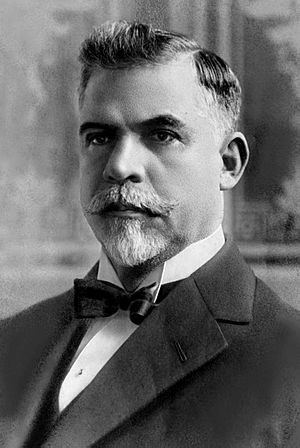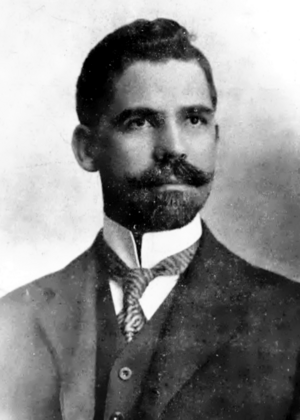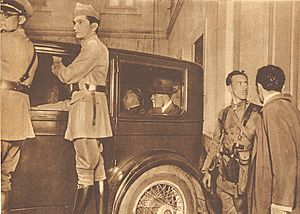Washington Luís facts for kids
Quick facts for kids
Washington Luís
|
|||||||||||||||||||||
|---|---|---|---|---|---|---|---|---|---|---|---|---|---|---|---|---|---|---|---|---|---|

Official portrait, 1926
|
|||||||||||||||||||||
| President of Brazil | |||||||||||||||||||||
| In office 15 November 1926 – 24 October 1930 |
|||||||||||||||||||||
| Vice President | Melo Viana | ||||||||||||||||||||
| Preceded by | Artur Bernardes | ||||||||||||||||||||
| Succeeded by | Military Junta (interim) | ||||||||||||||||||||
|
|||||||||||||||||||||
| Personal details | |||||||||||||||||||||
| Born | 26 October 1869 Macaé, Rio de Janeiro, Empire of Brazil |
||||||||||||||||||||
| Died | 4 August 1957 (aged 87) São Paulo, São Paulo, Brazil |
||||||||||||||||||||
| Political party | PRP | ||||||||||||||||||||
| Spouse |
Sofia Paes de Barros
(m. 1900; died 1934) |
||||||||||||||||||||
| Children | Florinda Rafael Luís Caio Luís Vítor Luís |
||||||||||||||||||||
| Parents |
|
||||||||||||||||||||
| Alma mater | Faculty of Law of Largo de São Francisco | ||||||||||||||||||||
| Signature | |||||||||||||||||||||
Washington Luís Pereira de Sousa (born October 26, 1869 – died August 4, 1957) was an important Brazilian politician. He became the 13th president of Brazil. Before that, he was elected governor of São Paulo state in 1920.
Washington Luís was part of the Republican Party of São Paulo (PRP). He was the last president of the First Brazilian Republic, which was a period when Brazil was a republic for the first time. During his time as president, a big economic problem called the Great Depression hit the world. This made him lose a lot of support. He chose his friend Júlio Prestes to be the next president in 1930. However, just a few weeks before his term ended, Washington Luís was removed from power. This happened during a sudden change in government called the Brazilian Revolution of 1930. A group of military leaders took over for a short time.
Contents
Early Life and Political Start
Washington Luís was born in Macaé, a city in Rio de Janeiro, Brazil. His family had roots from Portugal. He later moved to São Paulo, where he went to school. In 1891, he finished his law degree at the University of São Paulo Law School.
After studying law, he started his political journey. He worked as a prosecutor for a short time. Then, he moved to Batatais, São Paulo, where he became an alderman (a local council member). He even served as the mayor of Batatais from 1898 to 1899. This was the beginning of his rise in politics.
Rising Through the Ranks
Washington Luís continued to gain experience in government. He was elected as a congressman in 1900. Later, he became a state representative for the Paulista Republican Party (PRP) from 1904 to 1906. During this time, he helped update the Constitution of São Paulo state.
From 1906 to 1912, he held a very important job as the Secretary of State of Justice and Public Safety. This role involved overseeing justice and keeping the public safe in São Paulo. He then served again as a state representative.
In 1914, he became the mayor of São Paulo city. He held this position until 1919. During his time as mayor, he had to deal with a big event: the general strike of 1917, where many workers stopped working to demand better conditions. After being mayor, he became the governor of São Paulo state from 1920 to 1924. He even helped fight against a group of rebels in 1924. From 1925 to 1926, he served as a senator for São Paulo.
Becoming President
Washington Luís was elected president of Brazil in a direct election. He officially took office on November 15, 1926. His presidency was a time of big changes and challenges for Brazil.
One of his first actions was to end the Prestes Column, a group of rebels who had been causing trouble. They moved into Bolivia and then broke up. His government was no longer threatened by these rebellions. However, to control new protest movements, he created a law in 1927. This law limited freedom of the press and the right to gather in groups.
The world faced a huge economic problem in 1929, known as the stock market crash. This event, which started in the United States, affected many countries, including Brazil. Brazil's economy relied heavily on coffee exports. The price of coffee dropped a lot in the international market. This crisis made things very difficult for Washington Luís's government.
The End of His Presidency

For many years, Brazil had a political system called "coffee with milk politics." This meant that the president would usually be from São Paulo (coffee-producing state) or Minas Gerais (milk-producing state). The next president was expected to be from Minas Gerais. However, Washington Luís chose his friend, Júlio Prestes, who was also from São Paulo, to be the next president in 1930.
Júlio Prestes won the election on March 1, 1930. But many people believed the election was unfair. Things got worse when João Pessoa, a politician who was running for vice president with Getúlio Vargas, was killed on July 26, 1930. Even though it was later found that his death was not for political reasons, it sparked a lot of anger.
This event, combined with the coffee crisis, led to a major uprising. On October 3, 1930, a movement known as the Brazilian Revolution of 1930 began. President Washington Luís was removed from power by the military on October 24. A temporary military government took over.
After being removed from office, Washington Luís went to live in Europe and the United States. He returned to Brazil seventeen years later, in 1947. He settled in São Paulo and spent his time studying history. He was a respected member of several historical and cultural organizations. A major highway in São Paulo, the Rodovia Washington Luís, is named in his honor.
Later Life and Death
Washington Luís passed away in São Paulo on August 4, 1957, at the age of 87.
See also
 In Spanish: Washington Luís Pereira de Sousa para niños
In Spanish: Washington Luís Pereira de Sousa para niños




